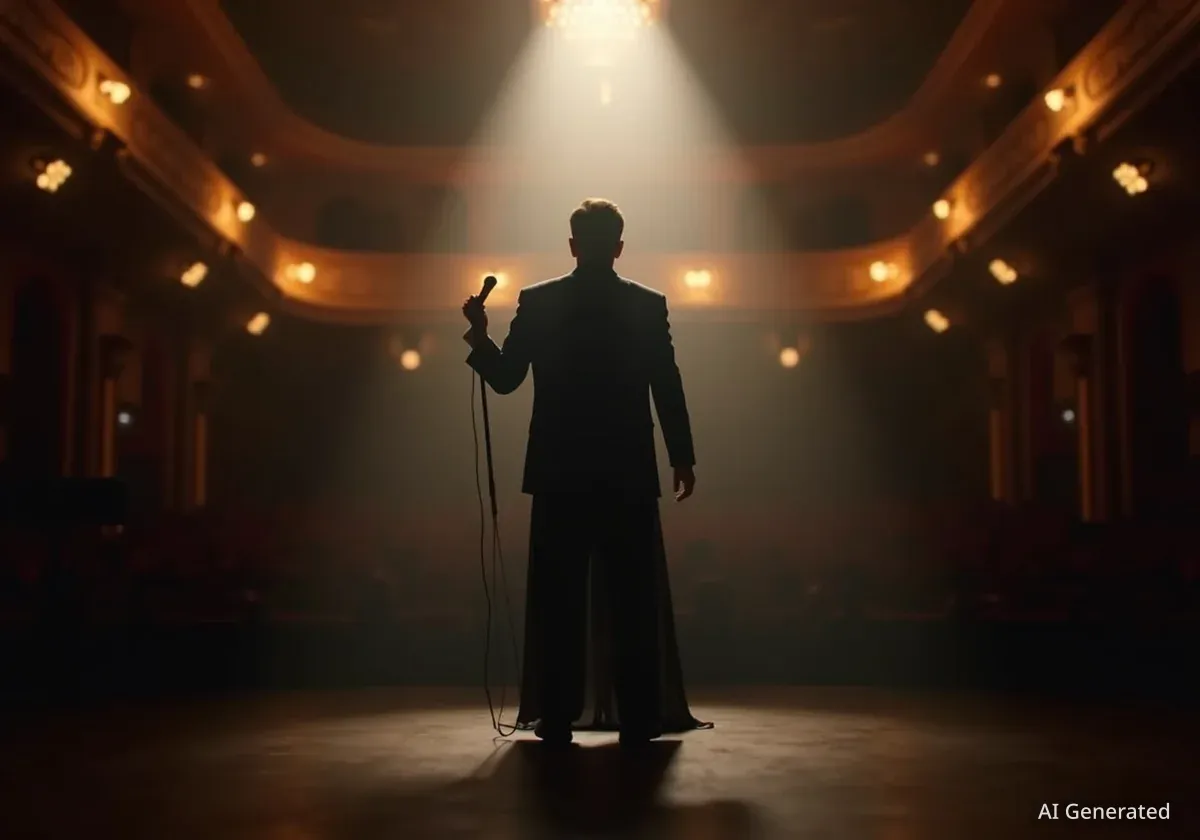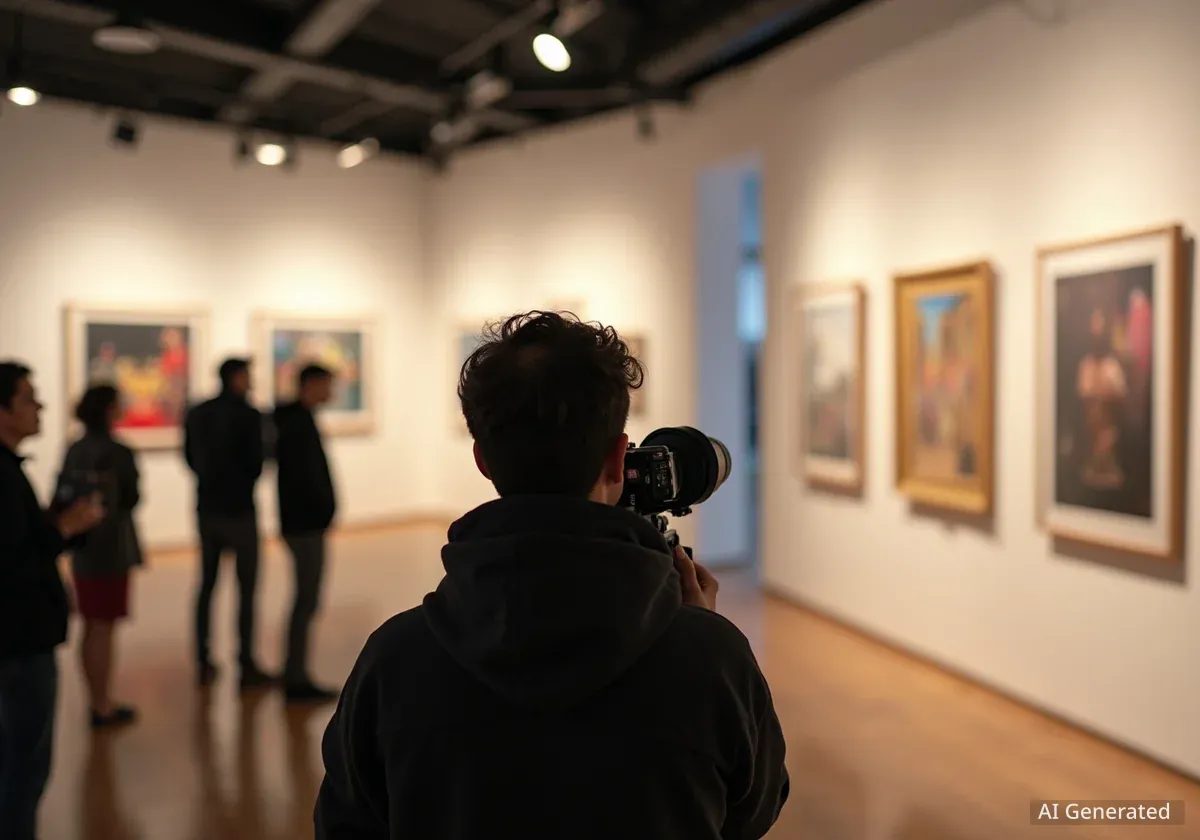Artist Tavares Strachan's first museum exhibition in Los Angeles, titled 'The Day Tomorrow Began,' is now on view at the Los Angeles County Museum of Art (LACMA). The exhibition combines art and science to highlight the often-overlooked achievements of marginalized people throughout history. Strachan, a native of Nassau, Bahamas, uses various mediums to explore themes of exploration, scientific inquiry, and the re-evaluation of historical narratives.
Key Takeaways
- Tavares Strachan's exhibit at LACMA runs until March 29.
- The show merges art, science, and history, focusing on hidden narratives.
- Strachan honors figures like Matthew Henson and Robert Henry Lawrence Jr.
- The exhibition features diverse elements, including neon, ceramics, and live performances.
- Strachan challenges conventional historical accounts and visibility.
Connecting Past and Future Through Art
Strachan's work aims to bridge different eras and disciplines. He blurs the lines between art, science, and historical understanding. The exhibition pushes viewers to question their perceptions of human progress. It also draws attention to how the accomplishments of Black individuals have frequently been excluded from official historical records.
One notable project honored America's first Black astronaut, Robert Henry Lawrence Jr. Lawrence died in a plane crash during training in 1968, before he could participate in a space mission. To commemorate him, Strachan sent a replica of an artwork inspired by Lawrence into Earth's orbit aboard a SpaceX rocket. This act symbolically fulfilled Lawrence's ambition to reach space.
Artist's Background
Tavares Strachan, 45, was born in Nassau, Bahamas. His early fascination with science and overlooked histories began during his childhood. He noticed a lack of diverse figures in the encyclopedias his family owned, sparking his interest in visibility and invisibility.
Highlighting Unsung Heroes
The exhibition features several pieces that bring attention to figures whose contributions were historically minimized. For example, Strachan depicts Robert Henry Lawrence Jr. in argon gas, trapped in electrified tubes. These tubes are shaped to resemble the human circulatory system, making his spirit visible within the artwork.
Another project involved Strachan traveling to the Alaskan Arctic. He carved a 4.5-ton block of ice, shipped it to the Bahamas, and displayed it in a solar-powered freezer. This installation served as a commentary on climate change, displacement, and global interconnectedness.
"The pieces of this particular exhibition that I think may hit people are when they start making connections on their own — the synapses start to fire," Strachan said during a tour. "You start to tie in, for example, the relationships between this polar explorer Matthew Henson and Robert Henry Lawrence. And then you start to think about the earlier explorers who left the African continent and this pioneering spirit that is a part of what it means to be African that is oftentimes not articulated or discussed."
Matthew Henson's Legacy
Strachan also highlights Matthew Henson, the Black explorer who accompanied Cmdr. Robert Peary on polar expeditions in 1909. Henson was likely the first human to reach the North Pole. However, his achievement remained largely unrecognized for many years due to his race. Strachan became the first Bahamian to visit the North Pole himself to understand the challenging conditions Henson faced.
In one striking piece, Strachan presents a moon sculpture with craters. A bust of Henson rests on its north pole, while an upside-down bust of Peary protrudes from the south pole. This arrangement visually reverses historical power dynamics, placing the focus on the overlooked explorer.
Challenging Historical Narratives
Curator Diana Nawi states that Strachan's work resists the "calcification of history." This refers to the process where dominant groups reinforce narratives that glorify themselves while ignoring or erasing the contributions of others. Nawi emphasizes that "histories are tools of power," and Strachan's art questions how this power can be reallocated to different people and ideas.
A Multisensory Experience
The exhibition, running until March 29, offers a diverse and engaging experience. It combines whimsical and serious elements. Live performances, scripted by Strachan and rooted in the Black experience, occur among museum visitors. These performances aim to break down the traditional barrier between art and spectator.
Visitors can experience a variety of artistic expressions:
- Illustrations and detailed diagrams.
- Displays of traditional African hairstyles.
- Mohair collages created in collaboration with South African weavers.
- Commemorative ceramic pieces.
- A field of rice grass designed to evoke specific olfactory memories with its straw-like scent.
Literary and Scientific Connections
Strachan, also a glassmaker, covers a wall with two neon signs. One spells out quotes by James Baldwin, appearing upright. The other displays quotes by Mark Twain, appearing upside down. This setup references both the wonders of chemistry and the ability of writing to analyze identity issues.
In another large room, dramatic bronze sculptures reinterpret the triumphs of Western civilization. They shift the focus to the oppressed, offering a different perspective on commonly accepted historical achievements. Strachan's work reflects his own rigorous training, which included cosmonaut exercises, creating a dialogue between concepts of boundlessness and constraint.
The Encyclopedia of Invisibility
Strachan's installation "Six Thousand Years" features 2,000 panels from his "Encyclopedia of Invisibility." This leather-bound book contains 17,000 entries written by Strachan to highlight little-known facts and Black trailblazers. It serves as a comprehensive effort to make visible what history has often rendered unseen.
Personal Journey and Cosmic Curiosity
Strachan's childhood in Nassau fueled his interest in hidden histories. Growing up, he felt that his 700-island archipelago was the center of the world. However, his curiosity expanded when he started working on a fishing boat at age 12. Weeks at sea, far from city lights, exposed him to countless stars and phosphorescent creatures in the waves. He learned to navigate by celestial bodies and read ocean currents, drawing on ancient knowledge passed down by his elders.
These experiences broadened his perspective, but also made him aware of the gaps in written history. He wondered why figures like Charles Darwin were widely known, but John Edmonstone, the formerly enslaved Black Briton who taught Darwin taxidermy, remained obscure. Strachan discovered Matthew Henson's achievements in his twenties, further solidifying his artistic direction.
"Science — that’s the place where knowledge is produced, and meaning," curator Diana Nawi said. "How do we know what we know? I think that’s fundamentally what [Strachan]’s asking."
Acts of Poetic Justice
Strachan's art often functions as an act of poetic justice. In a darkened room at the exhibition, a life-size glass "portrait" of astronaut Lawrence appears to float, free from gravity. His form is illuminated from within by argon gas in electrified tubes, making his essence visible. This piece metaphorically allows Lawrence to transcend Earth's atmosphere, achieving the space journey he never could in life.
"For me it’s important to ensure that when someone has done something incredible, that the level of storytelling is aligned with the nature of the act, hence the audacity of putting an object into space and trying to get his energy back into the cosmos," Strachan explained. He also aims to amaze young visitors with the technical skill behind creating such intricate glass objects.
The exhibition resonates with current discussions about historical revision. Curator Nawi noted the "toppling of monuments" in 2020 following George Floyd's murder, suggesting that "history is ripe for the retelling and the retaking." Strachan's work contributes to this ongoing conversation by offering new perspectives and celebrating forgotten pioneers.




